
by Larry Williams | Feb 26, 2019
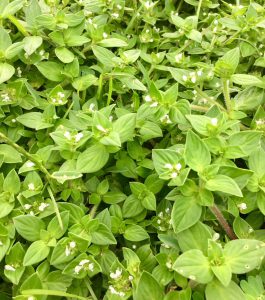
Florida pusley is common summer annual weed. Photo credit: Larry Williams
If weeds were a problem in your lawn last summer, the coming weeks are the time to apply a pre-emergence herbicide to prevent their emergence again this spring and summer.
Timing of a pre-emergence herbicide application for summer annual weeds such as crabgrass should be during February when day temperatures reach 65° to 70°F for four to five consecutive days. This generally coincides with when azaleas and dogwoods first begin to bloom. This in not when these plants are in full bloom but when the first flowers begin to open along the lower branches, particularly on azaleas. Note: This timing is not true for chamberbitter. Chamberbitter requires warmer soil temperatures to germinate. Apply a pre-emergence herbicide during April when battling chamberbitter.
Most pre-emergent type herbicides won’t work when applied after weeds are visible. The product must be applied just before seedlings emerge.
The weeds growing now in local lawns are not summer annuals. Summer annual weed seeds are still dormant awaiting warmer spring temperatures to germinate and emerge.
Most of the weeds in yards now are winter annuals. A few include annual bluegrass, chickweed, henbit, hop clover, lawn burweed and wild geranium.

Winter annual weeds in lawn. Photo credit: Larry Williams
A pre-emergence herbicide should have been applied during October to help prevent these weeds.
A few common summer annual weeds include crabgrass, Florida pusley, chamberbitter, sandspur, spotted spurge and doveweed.
If your lawn has a history of summer annual weeds, one control option is to apply a pre-emergence herbicide. Timing is critical in order for pre-emergence herbicides to work.
Look for lawn pre-emergence products that contain the active ingredients oryzalin, benefin, pendimethalin, DCPA or bensulide.
For season-long weed control, a second application may be needed about six to nine weeks after the initial application. To activate some products, irrigation or rain may be necessary following application. Because pre-emergence products may interfere with lawn grass seed germination, delay re-seeding six to sixteen weeks after application.
Overuse of some types of pre-emergence herbicides can cause a lawn to produce short stubby weak roots. So only apply the product if there is a pest to control – in this case, if you have had a history of summer annual weeds. Otherwise, save your money and time. Use pre-emergence herbicides only on lawns that have been established for at least a year. These products can severely injure newly planted lawns.
It is the user’s responsibility to read and follow all label directions and precautions when using any pesticide, including herbicides.
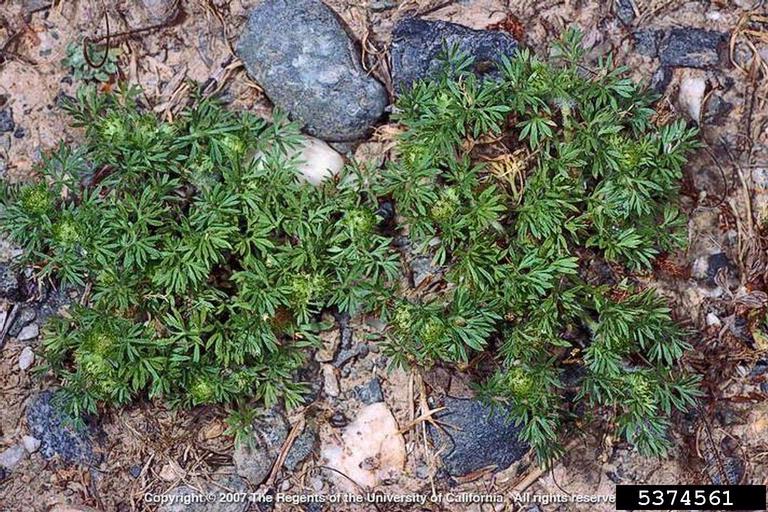
by Matthew Orwat | May 12, 2016
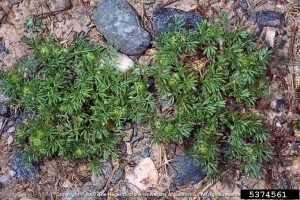
Burweed, Soliva Sessilis. – Image Credit: Joseph M. DiTomaso, University of California – Davis, Bugwood.org. Creative Commons License
This spring, lawn burweed has been an especially noticeable problem in lawns. Extension offices throughout Northwest Florida have been fielding many questions and finding solutions to lawn burweed infestations!
On the top of my list of lawn related annoyances is stepping into a patch of burweed, Soliva sessilis, which is in the sunflower family and is also known as spurweed. The leaves are opposite along the stem and sometimes resemble parsley. The main ways in which burweed can irk the casual gardener are sticking to socks, sneaking in with the dog, or littering flower beds with its nuisance. It can also hide in the house and reappear when shoes are removed. This causes pain in both the foot and the ear.
Aside from herbicides, maintaining a healthy vigorous lawn will prevent weeds from taking over. If your lawn is reasonably healthy and only a few instances of this weed exist, try to mechanically remove them and encourage the lawn to outgrow them.
If cultural methods aren’t sufficient, science has given us several options to control this irksome pest. Herbicides containing the active ingredients dicamba, 2,4-D or atrazine are good at controlling burweed as a post emergence control when applied from December through March. Be careful to use reduced rates on centipede and St. Augustine lawns, and never use more than the labeled rate since injury can occur when using these products on these species. Later applications have less effect on burweed because as it matures it is harder to control. Additionally the burs, once present on the lawn, are hard to remove. As the daytime temperatures rise to 90ºF, some of these herbicides may cause lawn damage. Try to keep the spray residue outside of the root zone of desirable plants to avoid injury and always follow label directions.
Be aware that burweed reproduces by seed, so mowing it down will only increase the problem by burying the seed for fall germination. Although we are now in the month of May, control of actively growing burweed might still be warranted if it is still flowering and setting seed. As temperatures warm up burweed will die, as it is a winter annual. In cases where it is already dying, control is not warranted since the natural cycle of winter annuals is concluding.
If an infestation of burweed has occurred this year, take note. The best time to apply pre-emergent herbicides to control burweed is in October. A widely used preemergence product for burweed control is isoxaben, which is sold under the brand name of Gallery as well as others. It prevents the weed from emerging from the ground when it germinates and can be used on St. Augustine, centipede, bahia and zoysia lawns, as well as in ornamental shrub beds. In northwest Florida, this herbicide needs to be applied in October for best results. A second application later in the season might be warranted. For more information about control, please consult this excellent article on lawn burweed management.
The active ingredients mentioned above are present in a variety of ‘trade name’ products* available from your local garden center, farm supply or co-op. Be sure to read label instructions carefully and contact your local extension office for any assistance. I hope all the northwest Florida lawn managers prevent burweed during the upcoming fall so that lawns will be burweed free next spring.
Happy Gardening!
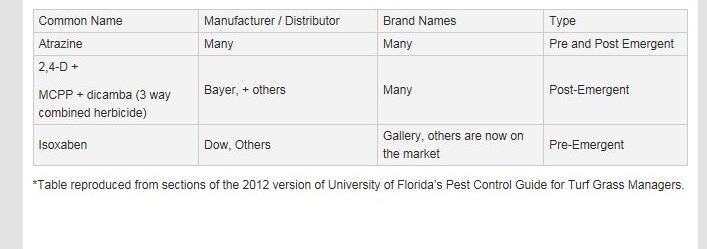
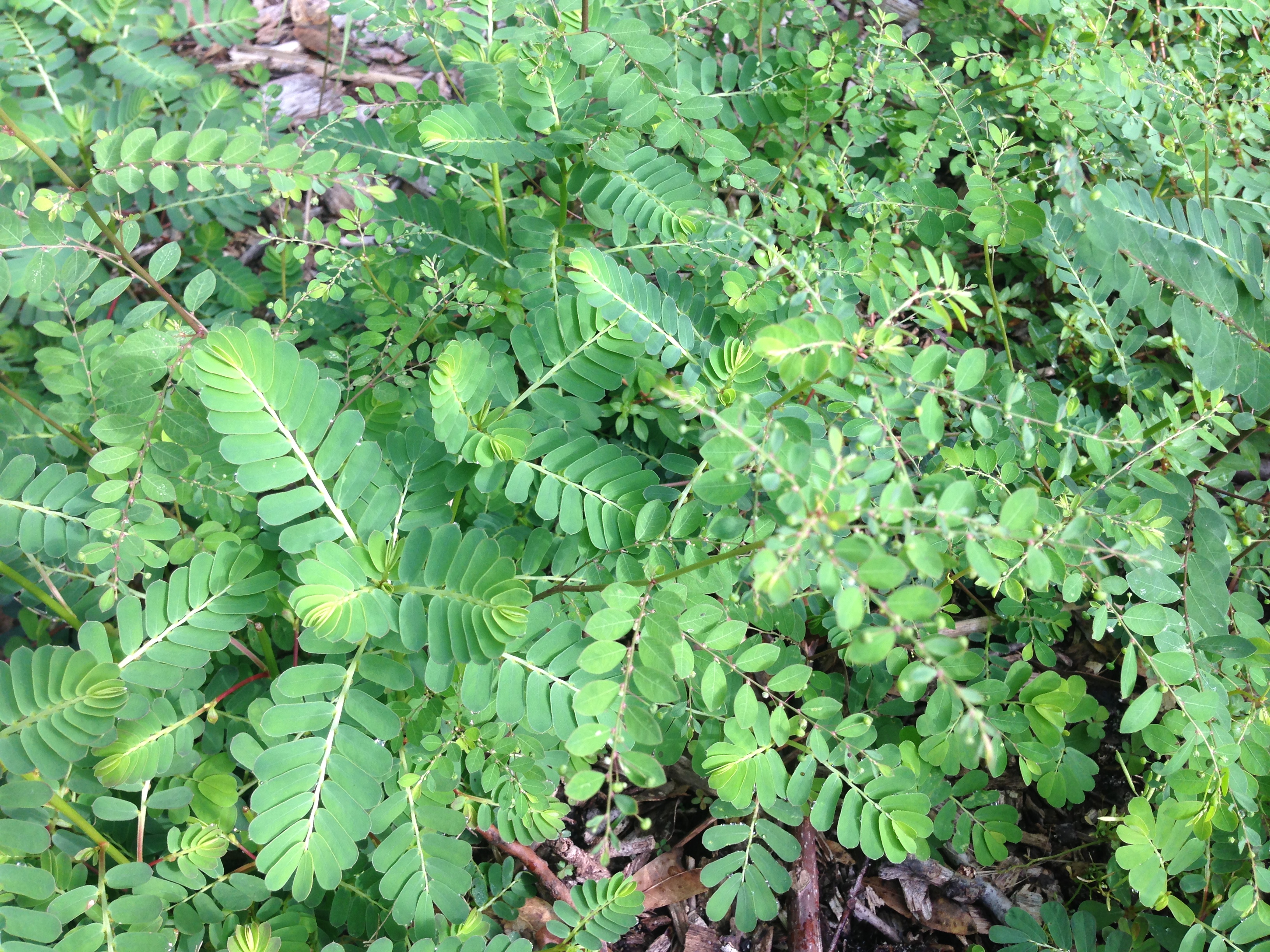
by Les Harrison | Aug 11, 2015
Weeds are growing everywhere, especially in manicured lawns and landscapes despite the best efforts of owners who have spared no expense to remove the offending flora. Herbicides to control the weeds seem to be less effective as August progresses.
The reality, at least about the herbicides, is different from perceived appearances. Herbicides can be a wonderful tool for the homeowner, if applied properly.
[important]The first point to remember about herbicides is to always, Always, ALWAYS apply them as instructed by the label directions. The oft quoted mantra of “the label is the law” is accurate.[/important]
Herbicides and their labeling are periodically reviewed and assessed to confirm effectiveness against target weeds without damaging the environment. Not following the label directions can have many negative implications for both the environment and the applicator.
Herbicides are either selective or non-selective when killing plants. Non-selective herbicides kill or damage every plant, but selective herbicides target a narrower range of plants.
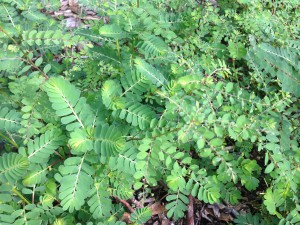
Chamberbitter, a common annual weed. Photo credit: Mary Derrick, UF/IFAS Extension.
Never apply herbicides when there is a breeze or wind. Herbicide drift can injure or destroy plants that are not the intended target.
High temperatures can contribute to the drift problem by volatizing some of the herbicide spray. Even the lightest air movement will cause drift off the target weeds when this condition exists. Herbicide drift can also be deposited in ponds and streams, harming the aquatic creatures that live there. Some herbicides are toxic to fish, insects and other animals that can be killed by tiny amounts of the active chemical. Additionally, the off target herbicides can kill aquatic plants. When the dead plants decay, they deplete the water of oxygen, again threatening or ending the life of the water’s residents.
Rain or dew resulting from high humidity can negate a herbicide’s application. If a leaf is wet, most or all the herbicide will run off on to the soil where it can leach into the water table.
Unless stated on the label, herbicides work only when the plant is actively growing. A hot, dry week or two can put a plant in drought mode, suspending growth and the herbicide’s effectiveness.
Many weeds have already produced seeds for next spring. Herbicides applied now will not affect the germination of that seed months from now.
The most effective strategy is to mow weeds before they set seed or to collect and destroy those which have already produced seed. Even with 100 percent success at eliminating this year’s weed seed crop, there will be weeds next year.
Some weed seed remain in the soil, sometimes for decades, only to germinate when conditions are perfect for their sprouting. Sickle pod and crotalaria are local examples of long term seed vigor.
Other seed can blow in or be dropped by wild or domestic animals passing through the property. A pre-emergent herbicide which stops germination can help control these latent invaders.
For more information:
Weed Management Guide for Florida Lawns
Gardening Solutions: Weeds
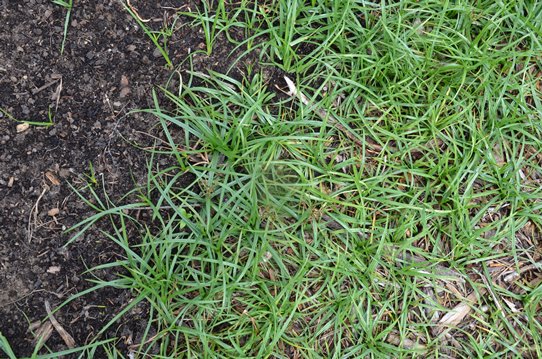
by Les Harrison | May 6, 2014

Purple Nut Sedge aggressively moves into any sunny open space and crowds out competitors.
The spring season in panhandle Florida is colorful. Every location from frequently manicured gardens to untended fields and pastures are exploding with hues and tones pleasing to the eye.
These heralds of the warmer weather to come are trailed by the warm season’s greenery which fills in the gaps between blooms. The consistent and ample rains have assured the continuance of a bright and pleasing landscape backed by countless shades and textures of green.
The adequate moisture has also assured the aggressive growth of an individually small, but collectively gigantic, weed which plagues every member of humanity associated with attempting to cultivate plants.
Purple nut sedge, Cyprus rotundus, has emerged en mass from every possible sunny location with soil. This native plant is a rapidly spreading perennial which will take every opportunity to colonize new locations.
The identifier purple is in the name because there is a purple-tinged section of this sedge where it emerges from the ground. The plant is sometimes referred to as purple nut grass because of its long narrow leaves and its erect growth pattern originate from a nutlike basal bulb.
There are other sedges in north Florida, but only yellow nut sedge is identified by a specific color. It is sometimes called chufa and is a popular feed for wild turkeys and turkey hunters.
The dark green, smooth leaves blend in easily with many turf grasses. Beneath the soil’s surface and out of sight, the root system grows in every direction.
Purple nut sedge’s roots are a series of spreading rhizomes and tubers or bulbs identified as nutlets. Each nutlet sprouts a new bunch of grass-like leaves and continues growing the rhizomes.
The densely population of this sedge quickly crowds out most other plants, but most especially turf and forage grasses. It can reach a height of 18 inches on its triangle shaped stem.
The root system’s design assures this plants survival and continued success. If pulled, the rhizomes break off leaving a large number of nutlets to develop and emerge at a later date.
If plowed or tilled, the nutlets are detached and spread to new and inviting locations. Many times nutlets lodge in tillage equipment only to shake loose and deposited in un-colonized locations.
Most herbicides have little on this sedge’s hardy root system. Selected pre-emergent herbicides will prevent many of the nutlets from germinating in spring.
North Florida’s sandier soils provide an ideal growing environment for purple nut sedge. The occasional periods of water saturation from storms do not deter this plant’s rapid and growth expansion to new areas, but it will not tolerate heavy shade.
Purple nut sedge’s extreme competitive nature is a heavy consumer of plant nutrients and robs rivals of important compounds necessary for their survival. Additionally, it produces an allelopathic substance which is toxic to some plants.
Purple nut sedge is found in many locales in North America where the environment is hospitable to its growth. The lush green leaves and touch of purple signify work for anyone who is maintaining a lawn or garden.
To learn more about purple nut sedge in north Florida contact your local UF/IFAS County Extension Office and read this informative publication on purple nutsedge.









